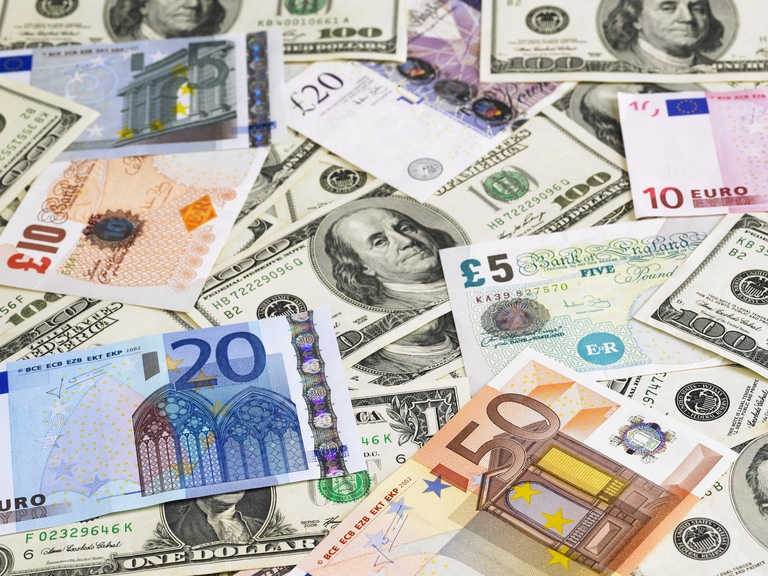After two days of solid gains, European markets have gone into full reverse today, falling sharply after US markets sold off into the close last night after San Francisco Fed President Mary Daly commented that the US central bank had more work to do when it comes to further rate hikes, which pulled US yields off their lows of the week.
Europe
Stocks got a further nudge lower after US PPI came in above expectations in July, rising more than expected, and pushing yields to their highs for the week.
Better than expected UK Q2 GDP numbers appear to have also prompted market weakness due to concern that the strength of today’s data might prompt the Bank of England to overplay their hand when it comes to tightening monetary policy further in the coming months.
By their own admission, the Bank of England has stated that monetary policy is already restrictive, yet markets continue to price in the prospect of another 50bps of rate hikes in the coming months, with all the inherent risks that might pose to the UK economy in the second half of this year.
This makes next week’s inflation and wages data even more important in the context of what actions the Bank of England takes next month when it comes to further rate hikes.
The FTSE100 is seeing some of the biggest falls, putting it on course for its 2nd successive weekly decline, with today’s weakness being driven by real estate where the risk of higher rates is being most keenly felt, with Land Securities, Segro, British Land and Rightmove all lower, as the UK 2-year gilt pushes back above 5%.
It’s also been a disappointing week for the basic resource sector over concerns over the economic outlook in China and demand for commodities, with the worst performers being Antofagasta, Rio Tinto and Anglo American.
Abrdn has also had a shocker of a week as investors absorb its H1 results of earlier this week, which saw outflows of £5.2bn from assets under management, raising the prospect that next week could see similar weakness in the likes of Aviva and Legal & General who are set to publish their own H1 numbers.
Apart from this morning’s UK GDP numbers there hasn’t been that much on the positive side, however Swiss bank UBS is on the up after announcing that it no longer required the loss protection guarantees from the Swiss government that came with its deal to buy Credit Suisse. The guarantees which included a backstop of CHF100bn was one of the pre-conditions that helped smooth the wheels of the deal when Credit Suisse ran into trouble. Having had more time to do its due diligence as well as paying such a low price it would appear UBS now has great confidence that it won’t need to avail itself of any of the measures, and as such will make it easier to absorb the rest of the bank into its own business.
US
US markets have taken their cues from today’s weaker European session, with the slightly firmer PPI numbers prompting a move higher in yields which is pushing the Nasdaq 100 to one-month lows. If today’s weakness is sustained, we could see the Nasdaq post its second successive weekly decline, the first time this year it has fallen two weeks in a row.
What’s been particularly notable this week is that chipmakers have seen some significant declines with the likes of Nvidia, AMD and Micron amongst some of the worst performers, as the air has continued to come out of the AI bubble.
Today’s Michigan confidence survey gave a slightly contrary view to today’s July PPI report, with inflation expectations for both 1 year and 5-10 year falling back to 3.3% and 2.9% respectively.
FX
The pound got a lift today after the UK economy expanded by 0.2% in Q2 helped by a strong performance in June where we saw an expansion of 0.5%. The strong showing in June was driven by services as the hot weather prompted consumers to go out and spend money on travel, hotels and restaurants, as well as other leisure pursuits.
We also saw a strong performance in construction and manufacturing with strong motor vehicle sales. The weak spots were in health and education due to industrial action, and while the resilience of the UK economy is welcome given the tough cost of living backdrop there is a concern that the Bank of England might derail this by further rate hikes in the coming months.
Next week’s inflation and wages numbers are likely to be a key factor in their deliberations, with a weak inflation number likely to offer encouragement as to whether we can avoid further rate rises. If the Bank of England deigned to look at PPI, input prices are already negative and by the central banks own admission, monetary policy is already restrictive. Why compound that with further hikes when you can leave rates where they are for longer.
The US dollar rebounded in the afternoon session after US PPI inflation came in slightly ahead of expectations, fuelling concerns that the disinflation impulse of the last 12 months has come to and end and that prices have based, and that the recent slowdown in prices could start to reverse.
Commodities
Gold continues to languish close to one-month lows with the rise in yields this week serving to keep a cap on prices, despite increasing evidence that inflation is continuing to slow. We appear to be at that point in the inflation cycle where a short-term uptick in prices after 12 months of slowing could prompt yields to push back towards recent highs, and thus place further pressure on gold prices.
Crude oil prices look to be on course for 7 weeks of gains, with prices up over 15% from the lows back in July, as they hit 6-month highs earlier this week. This increase in prices is raising concern that inflation could prove to be stickier in the coming weeks than most people think, as demand continues to recover and supply remains constrained by OPEC+ output cuts.
The weak growth outlook is also weighing on the copper price, sliding to one month lows this week, and down for the second week in succession, less than 2 weeks after hitting 3-month highs earlier this month.
Volatility
Natural gas prices rallied hard earlier in the week, but with a bigger than expected build of stocks being reported on Thursday, those gains proved to be somewhat short lived. The underlying lost around 8% at one point before reverting, with one day vol standing at 62.45% against 48.3% on the month.
CMC’s proprietary basket of stocks involved in the driverless car industry saw elevated levels of price action on Thursday, although it was legacy automakers Ford and General Motors that appeared to be the key drivers here. It’s seen as a case of falling car prices and the rising cost of financing these purchases that appears to be undermining sentiment, with both stocks coming under pressure. One day vol on the basket stood at 32.39% against 27.16% for the month.
Hong Kong’s Hang Seng index attempted something of a relief rally on Thursday, although the admittedly modest gains here proved to be rather short lived. News that the US is to limit investment into China appeared to take something of a toll, whilst hopes of another generous set of stimulus measures from Beijing are also waning. One day vol on the index printed 29.73% against 26.57% for the month.
And the New Zealand Dollar remains under pressure following those disappointing trade figures from China earlier in the week. The pair slipped to two and a half month lows and downside pressures appear to be persisting. One day vol stood at 11.71% against 11.49% on the month.






